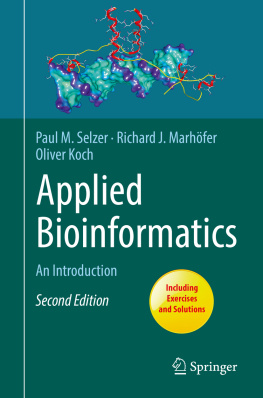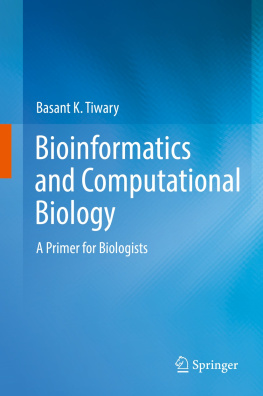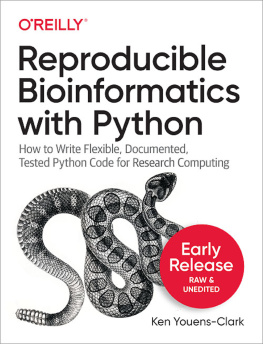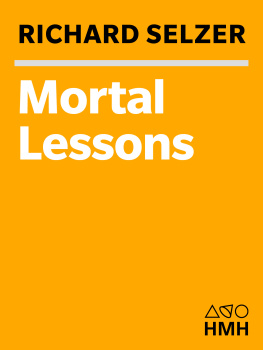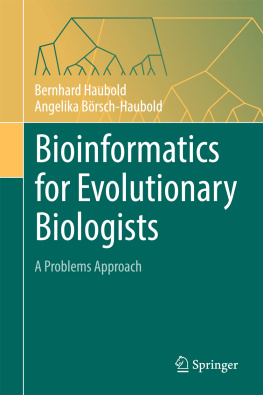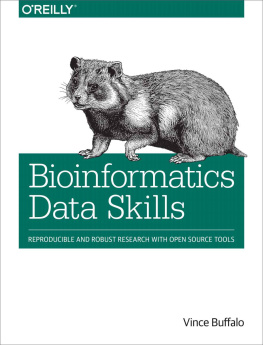Paul M. Selzer - Applied Bioinformatics
Here you can read online Paul M. Selzer - Applied Bioinformatics full text of the book (entire story) in english for free. Download pdf and epub, get meaning, cover and reviews about this ebook. year: 0, publisher: Springer International Publishing, genre: Home and family. Description of the work, (preface) as well as reviews are available. Best literature library LitArk.com created for fans of good reading and offers a wide selection of genres:
Romance novel
Science fiction
Adventure
Detective
Science
History
Home and family
Prose
Art
Politics
Computer
Non-fiction
Religion
Business
Children
Humor
Choose a favorite category and find really read worthwhile books. Enjoy immersion in the world of imagination, feel the emotions of the characters or learn something new for yourself, make an fascinating discovery.
- Book:Applied Bioinformatics
- Author:
- Publisher:Springer International Publishing
- Genre:
- Year:0
- Rating:3 / 5
- Favourites:Add to favourites
- Your mark:
- 60
- 1
- 2
- 3
- 4
- 5
Applied Bioinformatics: summary, description and annotation
We offer to read an annotation, description, summary or preface (depends on what the author of the book "Applied Bioinformatics" wrote himself). If you haven't found the necessary information about the book — write in the comments, we will try to find it.
Applied Bioinformatics — read online for free the complete book (whole text) full work
Below is the text of the book, divided by pages. System saving the place of the last page read, allows you to conveniently read the book "Applied Bioinformatics" online for free, without having to search again every time where you left off. Put a bookmark, and you can go to the page where you finished reading at any time.
Font size:
Interval:
Bookmark:


This Springer imprint is published by the registered company Springer International Publishing AG part of Springer Nature
The registered company address is: Gewerbestrasse 11, 6330 Cham, Switzerland
Though a relatively young discipline, bioinformatics is finding increasing importance in many life science disciplines, including biology, biochemistry, medicine, and chemistry. Since its beginnings in the late 1980s, the success of bioinformatics has been associated with rapid developments in computer science, not least in the relevant hardware and software. In addition, biotechnological advances, such as have been witnessed in the fields of genome sequencing, microarrays, and proteomics, have contributed enormously to the bioinformatics boom. Finally, the simultaneous breakthrough and success of the World Wide Web has facilitated the worldwide distribution of and easy access to bioinformatics tools.
Today, bioinformatics techniques, such as the Basic Local Alignment Search Tool (BLAST) algorithm, pairwise and multiple sequence comparisons, queries of biological databases, and phylogenetic analyses, have become familiar tools to the natural scientist. Many of the software products that were initially unintuitive and cryptic have matured into relatively simple and user-friendly products that are easily accessible over the Internet. One no longer needs to be a computer scientist to proficiently operate bioinformatics tools with respect to complex scientific questions. Nevertheless, what remains important is an understanding of fundamental biological principles, together with a knowledge of the appropriate bioinformatics tools available and how to access them. Also and not least important is the confidence to apply these tools correctly in order to generate meaningful results.
The present, comprehensively revised second English edition of this book is based on a lecture series of Paul M. Selzer, professor of biochemistry at the Interfaculty Institute for Biochemistry, Eberhard-Karls-University, Tbingen, Germany, as well as on multiple international teaching events within the frameworks of the EU FP7 and Horizon 2020 programs. The book is unique in that it includes both exercises and their solutions, thereby making it suitable for classroom use. Based on both the huge national success of the first German edition from 2004 and the subsequently overwhelming international success of the first English edition from 2008, the authors decided to produce a second German and English edition in close proximity to each other. Working on the same team, each of the three authors had many years of accumulated expertise in research and development within the pharmaceutical industry, specifically in the area of bioinformatics and cheminformatics, before they moved to different career opportunities to widen their individual industrial and academic scientific areas of expertise. The aim of this book is both to introduce the daily application of a variety of bioinformatics tools and provide an overview of a complex field. However, the intent is neither to describe nor even derive formulas or algorithms, but rather to facilitate rapid and structured access to applied bioinformatics by interested students and scientists. Therefore, detailed knowledge in computer programming is not required to understand or apply this books contents.
Each of the seven chapters describes important fields in applied bioinformatics and provides both references and Internet links. Detailed exercises and solutions are meant to encourage the reader to practice and learn the topic and become proficient in the relevant software. If possible, the exercises are chosen in such a way that examples, such as protein or nucleotide sequences, are interchangeable. This allows readers to choose examples that are closer to their scientific interests based on a sound understanding of the underlying principles. Direct input required by the user, either through text or by pressing buttons, is indicated in Courier font and italics , respectively. Finally, the book concludes with a detailed glossary of common definitions and terminology used in applied bioinformatics.
We would like to thank our former colleague and coauthor of the first edition, Dr. Andreas Rohwer, for his contributions, which are still of great importance in the second edition. We are very grateful to Ms. Christiane Ehrt and Ms. Lina Humbeck TU Dortmund, Germany for mindfully reading the book and actively verifying all exercises and solutions. We wish to thank Dr. Sandra Noack for her constructive contributions. Finally, we wish to thank Ms. Stefanie Wolf and Ms. Sabine Schwarz from the publisher Springer for their continuous support in producing the second edition.
Genetic information is encoded by a 4-letter alphabet, which in turn is translated into proteins using a 20-letter alphabet. Proteins fold into three-dimensional structures that perform essential functions in single-celled or multicellular organisms. These organisms are under constant selection pressure, which in turn leads to changes in their genetic information.
Font size:
Interval:
Bookmark:
Similar books «Applied Bioinformatics»
Look at similar books to Applied Bioinformatics. We have selected literature similar in name and meaning in the hope of providing readers with more options to find new, interesting, not yet read works.
Discussion, reviews of the book Applied Bioinformatics and just readers' own opinions. Leave your comments, write what you think about the work, its meaning or the main characters. Specify what exactly you liked and what you didn't like, and why you think so.

